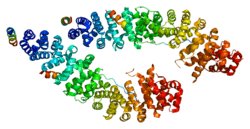BCL9
| View/Edit Human | View/Edit Mouse |
B-cell CLL/lymphoma 9 protein is a protein that in humans is encoded by the BCL9 gene.[4][5]
Function
BCL9, together with its paralogue gene BCL9L (BCL9 like or BCL9.2), have been extensively studied for their role as transcriptional beta-catenin cofactors, fundamental for the transcription of Wnt target genes.[6]
BCL9 and BCL9L have been shown to take part in other tissue-specific molecular mechanisms, showing that their role in the Wnt signaling cascade is only one aspect of their mode of action.[7]
Clinical significance
BCL9 is associated with B-cell acute lymphoblastic leukemia. It may be a target of translocation in B-cell malignancies with abnormalities of 1q21. The overexpression of BCL9 may be of pathogenic significance in B-cell malignancies.[5]
BCL9 and BCL9L are potential clinical targets for human cancers; for instance, the gene expression changes that they promote is associated with a poor outcome in colorectal cancer.[8]
Like BCL2, BCL3, BCL5, BCL6, BCL7A, and BCL10, it has clinical significance in lymphoma.
Common variations in the BCL9 gene, which is in the distal area, confer risk of schizophrenia and may also be associated with bipolar disorder and major depressive disorder.[9]
Related gene problems
References
- ↑ "Diseases that are genetically associated with BCL9 view/edit references on wikidata".
- ↑ "Human PubMed Reference:".
- ↑ "Mouse PubMed Reference:".
- ↑ Willis TG, Zalcberg IR, Coignet LJ, Wlodarska I, Stul M, Jadayel DM, Bastard C, Treleaven JG, Catovsky D, Silva ML, Dyer MJ (Mar 1998). "Molecular cloning of translocation t(1;14)(q21;q32) defines a novel gene (BCL9) at chromosome 1q21". Blood. 91 (6): 1873–81. PMID 9490669.
- 1 2 "Entrez Gene: BCL9 B-cell CLL/lymphoma 9".
- ↑ Mosimann C, Hausmann G, Basler K (Apr 2009). "Beta-catenin hits chromatin: regulation of Wnt target gene activation". Nature Reviews. Molecular Cell Biology. 10 (4): 276–86. doi:10.1038/nrm2654. PMID 19305417.
- ↑ Cantù C, Zimmerli D, Hausmann G, Valenta T, Moor A, Aguet M, Basler K (Sep 2014). "Pax6-dependent, but β-catenin-independent, function of Bcl9 proteins in mouse lens development". Genes & Development. 28 (17): 1879–84. doi:10.1101/gad.246140.114. PMC 4197948
 . PMID 25184676.
. PMID 25184676. - ↑ Moor AE, Anderle P, Cantù C, Rodriguez P, Wiedemann N, Baruthio F, Deka J, André S, Valenta T (2015-12-01). "BCL9/9L-β-catenin Signaling is Associated With Poor Outcome in Colorectal Cancer". EBioMedicine. 2 (12): 1932–1943. doi:10.1016/j.ebiom.2015.10.030.
- ↑ Li J, Zhou G, Ji W, Feng G, Zhao Q, Liu J, Li T, Li Y, Chen P, Zeng Z, Wang T, Hu Z, Zheng L, Wang Y, Shen Y, He L, Shi Y (2011). "Common variants in the BCL9 gene conferring risk of schizophrenia". Archives of General Psychiatry. 68 (3): 232–40. doi:10.1001/archgenpsychiatry.2011.1. PMID 21383261.
Further reading
- Busson-Le Coniat M, Salomon-Nguyen F, Dastugue N, Maarek O, Lafage-Pochitaloff M, Mozziconacci MJ, Baranger L, Brizard F, Radford I, Jeanpierre M, Bernard OA, Berger R (Dec 1999). "Fluorescence in situ hybridization analysis of chromosome 1 abnormalities in hematopoietic disorders: rearrangements of DNA satellite II and new recurrent translocations". Leukemia. 13 (12): 1975–81. doi:10.1038/sj/leu/2401587. PMID 10602418.
- Kramps T, Peter O, Brunner E, Nellen D, Froesch B, Chatterjee S, Murone M, Züllig S, Basler K (Apr 2002). "Wnt/wingless signaling requires BCL9/legless-mediated recruitment of pygopus to the nuclear beta-catenin-TCF complex". Cell. 109 (1): 47–60. doi:10.1016/S0092-8674(02)00679-7. PMID 11955446.
- Knoll A, Dvorák J, Rohrer GA, Cepica S (Apr 2002). "Linkage and cytogenetic mapping of the BCL9 gene to porcine chromosome 4". Animal Genetics. 33 (2): 162–3. doi:10.1046/j.1365-2052.2002.0831e.x. PMID 12047235.
- Townsley FM, Thompson B, Bienz M (Feb 2004). "Pygopus residues required for its binding to Legless are critical for transcription and development". The Journal of Biological Chemistry. 279 (7): 5177–83. doi:10.1074/jbc.M309722200. PMID 14612447.
- Hoffmans R, Basler K (Sep 2004). "Identification and in vivo role of the Armadillo-Legless interaction". Development. 131 (17): 4393–400. doi:10.1242/dev.01296. PMID 15294866.
- Beausoleil SA, Jedrychowski M, Schwartz D, Elias JE, Villén J, Li J, Cohn MA, Cantley LC, Gygi SP (Aug 2004). "Large-scale characterization of HeLa cell nuclear phosphoproteins". Proceedings of the National Academy of Sciences of the United States of America. 101 (33): 12130–5. doi:10.1073/pnas.0404720101. PMC 514446
 . PMID 15302935.
. PMID 15302935. - Sampietro J, Dahlberg CL, Cho US, Hinds TR, Kimelman D, Xu W (Oct 2006). "Crystal structure of a beta-catenin/BCL9/Tcf4 complex". Molecular Cell. 24 (2): 293–300. doi:10.1016/j.molcel.2006.09.001. PMID 17052462.
- Hoffmans R, Basler K (Jan 2007). "BCL9-2 binds Arm/beta-catenin in a Tyr142-independent manner and requires Pygopus for its function in Wg/Wnt signaling". Mechanisms of Development. 124 (1): 59–67. doi:10.1016/j.mod.2006.09.006. PMID 17113272.


